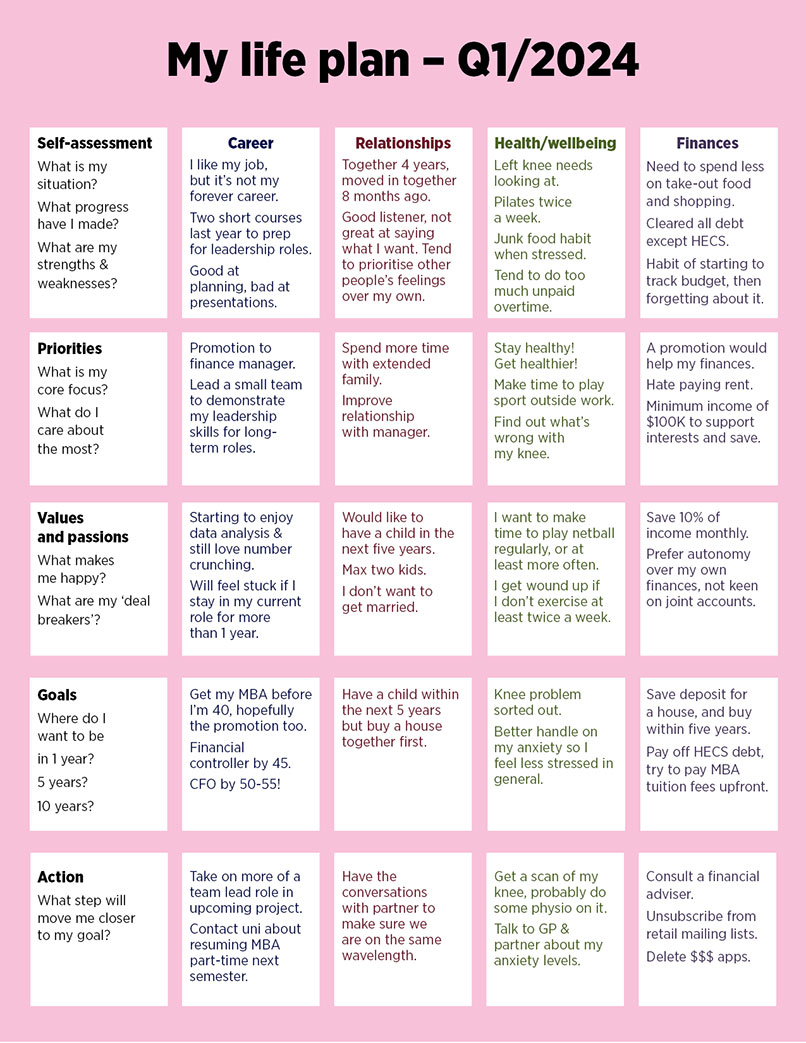Loading component...
At a glance
By Beth Wallace
While professionals often set goals and devise strategies on behalf of their employer, they may be less inclined to apply the same practices to their personal life.
In addition to fostering a sense of purpose and direction, setting both professional and personal goals can help people to avoid long-term regret about not living the life they intended, says Sharon McClafferty, CEO of Brisbane-based accounting and business coaching firm Slipstream Group.
One way for employees to develop and document goals is through a life plan, which is also known as a personal business plan.
A life plan is an effective tool that can be used to articulate – and achieve – goals in all areas of life, including career, relationships, health and finances.
“Taking time to create a personal plan draws a line in the sand, that you are going to think consciously about the life you want,” McClafferty says.
Ask tough questions
The career element of a life plan should outline what people want to do more of, or do differently, to help them get where they want to go in their career, says Rachel Service, CEO of Happiness Concierge and author of There Has To Be More – The Essential Guide to Personal Growth.
“Ask yourself honestly, ‘What do I want my career to provide me in my lifetime?’” Service suggests.
This might include a sense of purpose, financial security or intellectual stimulation, she adds.
Assess your current role
Next, people should identify what is working well in their current role, as well as areas they can “stretch” in. This could include building on technical expertise or nurturing valuable relationships.
Employees could share their self-assessment with a manager to seek feedback and highlight any areas where they can support the business to achieve its objectives.
Start slow, win fast
When implementing a life plan, Service recommends starting slow.
“You might have quite a few ideas on things you’d love to prioritise, but just choose one,” she suggests. “If you want to see results, limiting your focus is the way to do it.”
Reflect on progress
Celebrating learnings and wins is likewise important. At work, this might mean scheduling monthly or quarterly reflections on the progress that is being made and sharing these observations with a manager.
“When you share what you are learning, you are so much more likely to retain it,” Service explains.
Support employees
In addition to benefitting individuals, employers can use life planning as a tool to help employees to develop their goals.
By guiding them through this process, employers can demonstrate that they are invested in employee wellbeing. This can improve retention, with research revealing that staff are significantly more likely to stay with a company when they feel cared for.
When people create a life plan, it can also help them to realise they need to “up their game”, McClafferty says. This can motivate them to learn new skills, which is an obvious win for their employer.
Plus, McClafferty adds, “happier, healthier team members are a win for any business owner”.
4 tips for building a life plan
Sharon McClafferty, CEO of Slipstream Group, offers key tips for developing a successful, useful life plan.
1. Write it down
Once written down, a life plan can be “so galvanising”, McClafferty says.
“You realise you’ve been thinking in a haphazard way about your life. This takes it to a much more structured and deliberate process.”
A life planning chart (see Figure 1) may also be useful.

2. Workshop it
One method for developing a life plan is through workshopping.
Through Slipstream, for instance, McClafferty runs personal planning workshops for individuals that explore their personal values, abilities and passions, taking these into consideration in developing the plan.
A workshopping process can also prompt people to think about things they might not think of on their own, such as the legacy they want to leave and the activities they feel are most worth their time.
3. Develop a timeline
A timeline is essential to a life plan because it provides a useful, realistic estimate about how long it will take to achieve life and career objectives.
One option is to map out a 10-year plan and include on it everything from holidays and fitness milestones to buying a house, starting a family or reaching a financial goal.
4. Work backwards
To work backwards, the planning workshop participants first identify what they ultimately want out of life, then plot the steps required to get them there, McClafferty says.
This does empower people to articulate their key priorities. However, McClafferty admits it also forces them to consider some uncomfortable trade-offs, such as whether they are prepared to sacrifice time with family for work or, on the flipside, potentially reduce income and career opportunities to spend time at home.

